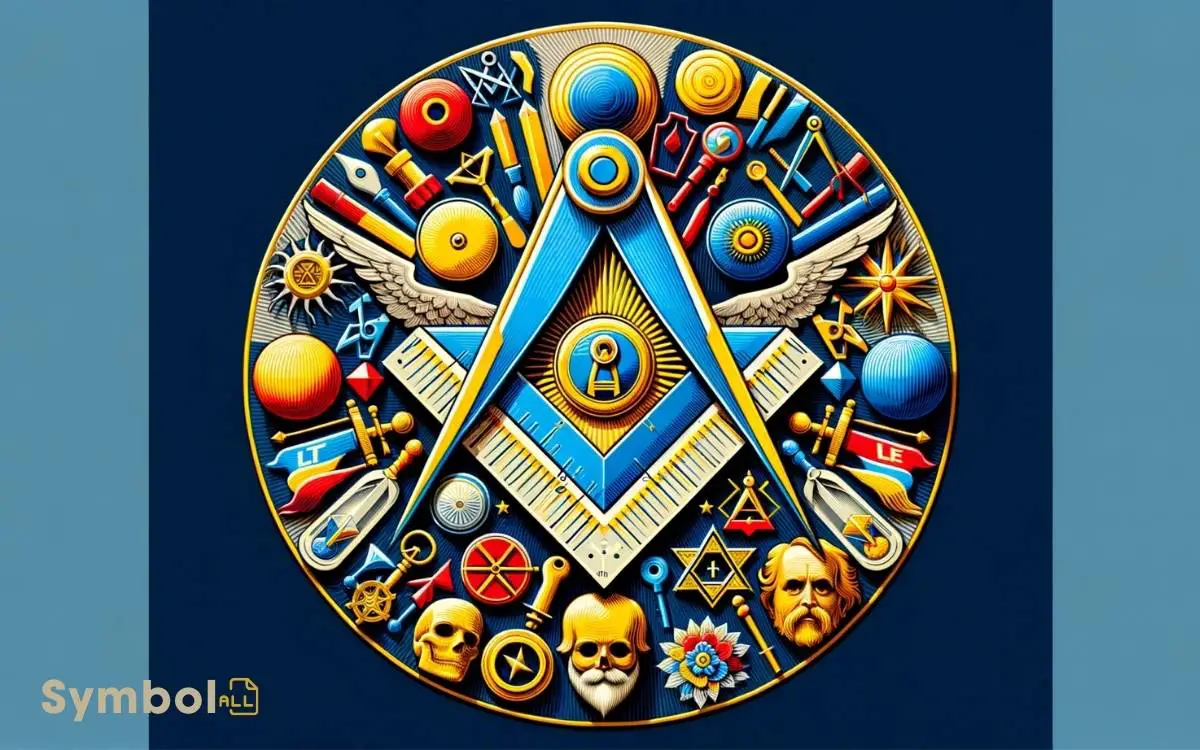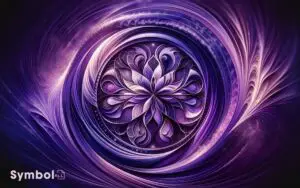Masonic Colors and Their Symbolism: A Comprehensive Guide
In Freemasonry, each color isn’t just a hue; it’s a story, reflecting core values and teachings.
Blue, for example, isn’t merely a color but signifies truth, fidelity, and the quest for moral fortitude, marking the beginning of Masonic education.
White represents purity and initiation, symbolizing a Mason’s journey toward enlightenment and moral purity.
On a deeper level, colors like black mourn life’s impermanence, while green celebrates rebirth and eternal life.
Such symbolism extends to gold’s perfection, purple’s authority, and beyond, encoding the fraternity’s profound spiritual and moral principles.
Each shade serves as a chapter in an elaborate narrative, inviting you to explore further into Masonic traditions and beliefs.

Key Takeaway
Understanding Masonic Colors and Their Symbolism
| Color | Symbolism | Associated Degree or Order |
|---|---|---|
| Blue | Universal friendship and benevolence | Blue Lodge (Craft Freemasonry) |
| Red | Zeal and fortitude | Royal Arch Masonry |
| Purple | Royal color, representing sovereignty | Cryptic Masonry, high degrees |
| White | Purity and innocence | Masonic funerals, some rituals |
| Black | Grief and fidelity | Mourning and remembrance |
| Green | Immortality of the soul, renewal, nature | Ancient Craft Masonry |
| Gold | Enlightenment and treasure of the fraternity | High degrees, honorary positions |
| Silver | Serenity and nobility | Officer jewels, regalia |
| Yellow | Hazard but also a call to duty and sacrifice | Standard Masonic regalia |
| Rose | Dawn of a new era, joy, and happiness | Order of the Eastern Star |
| Royal Blue | Eternity and fidelity | Royal Arch Masonry |
| Sky Blue | Perfection and hope | Blue Lodge |
| Apricot | Reward of merit and learning | Officers of the Grand Lodge |
| Brown | Mother Earth and stability | Some Masonic jurisdictions |
| Grey | Neutrality and balance | Unknown |
The Significance of Blue
Within the rich tapestry of Masonic symbolism, the color blue holds a place of paramount importance, serving as a cornerstone for much of its ritualistic and philosophical underpinnings.
You’ll find that blue, often referred to as ‘Masonic Blue,’ symbolizes truth and universality. It’s a reflection of the sky and the sea, embodying both the divine and the profound depths of human insight.
This color isn’t chosen randomly; it signifies fidelity, loyalty, and trustworthiness, qualities every Mason endeavors to embody.
Blue lodges, or Craft Lodges, are foundational to Freemasonry, denoting the entry-level of Masonic education and practice.
Through this lens, you begin to see how blue isn’t just a color but a narrative thread that weaves through the very fabric of Masonic identity, teaching and reminding members of their eternal quest for truth and moral fortitude.
White: Purity and Initiation
As you explore the significance of white in Freemasonry, you’ll uncover its deep-rooted association with purity and the profound role it plays in initiation rituals.
This color symbolizes a blank slate, representing the Mason’s journey from darkness into enlightenment.
Analyzing its usage not only reveals insights into Masonic tradition but also underscores the transformative process individuals undergo during their initiation.
Symbolism of White
Delving into the symbolism of white in Masonic traditions reveals its deep association with purity and the initiation process.
White, in Masonic lore, symbolizes a clean slate, offering a foundation upon which the initiation process builds.
This color’s symbolism is multifaceted, embodying notions of beginning, renewal, and enlightenment.
- A Clean Slate: Represents the aspirant’s state before gaining Masonic knowledge.
- Renewal: Symbolizes the rebirth of the individual through Masonic rites.
- Enlightenment: White is associated with light, embodying the pursuit of wisdom.
- Unblemished Character: Suggests the moral purity expected of members.
This color’s use in Masonry isn’t merely aesthetic but is laden with deep symbolic meaning, reflecting core values and the transformative journey of its members.
Purity in Freemasonry
Exploring the concept of purity in Freemasonry reveals that the color white serves as a profound emblem of purity and the initiation process, embodying the ideals and transformative journey embraced by Masonic tradition.
White symbolizes a blank slate or the primal purity from which one commences on the path of self-improvement and enlightenment intrinsic to Masonic philosophy.
It represents the aspirant’s purity of intent and dedication to the principles of Freemasonry, such as brotherly love, relief, and truth.
As you explore further into this tradition, you’ll find that the emphasis on white in Masonic regalia and symbols isn’t merely aesthetic but carries deep philosophical connotations.
It underscores the fraternity’s commitment to fostering an environment where members can pursue moral and spiritual purification.
Initiation Rituals Explained
The initiation rituals of Freemasonry intricately weave the symbolism of white, underscoring its significance in representing purity and the beginning of an aspirant’s journey toward enlightenment.
This color isn’t chosen arbitrarily; it’s a deliberate emblem of a clean slate, readiness to receive sacred knowledge, and an open heart to the teachings and values of Freemasonry.
- Emblem of new beginnings: White signifies a fresh start in the Masonic journey.
- Symbol of purity: It reflects the aspirant’s sincere intentions and moral fortitude.
- Canvas for learning: White represents the unwritten future of the initiate, ready to be inscribed with wisdom.
- Universal Brotherhood: It unites all members, transcending individual differences, in their quest for spiritual and moral improvement.
Black and Mourning Traditions
In the domain of Masonic symbolism, black embodies more than mere absence of color; it serves as a profound emblem of mourning and reflection.
You’ll find that mourning rituals within the Masonic tradition are steeped in historical practices, with specific attire and accessories playing pivotal roles in the observance of loss.
This exploration into the symbolism of black, coupled with an analysis of mourning rituals, attire, and accessories, reveals layers of meaning intrinsic to the Masonic ethos.
Symbolism of Black
Delving into the symbolism of black within Masonic traditions reveals its deep association with mourning and solemn remembrance.
This color, profound and encompassing, serves as a stark reminder of life’s impermanence, urging contemplation and respect for the deceased.
The symbolism of black in Masonic practices isn’t merely aesthetic; it’s steeped in layers of significance that merit a closer look.
- Universality: Black transcends cultural boundaries, embodying a universal symbol for loss and respect across nations.
- Transition: Represents the passage from the material world to the eternal, highlighting life’s cyclical nature.
- Reflection: Encourages introspection among the brethren, fostering a deeper connection with the spiritual domain.
- Equality: In mourning, all members stand equal, united in their grief and remembrance, irrespective of their worldly status.
Mourning Rituals Explained
Mourning rituals within Masonic traditions serve as a profound proof to the fraternity’s reverence for the cycle of life and death, intricately weaving the symbolism of black into ceremonies that honor the departed.
These rituals aren’t merely about grief; they encapsulate respect, remembrance, and the philosophical acceptance of mortality.
You’ll find that each element of the ceremony, from the solemn procession to the use of specific symbols, is laden with meaning.
They’re designed to provoke contemplation on the impermanence of life and the virtues of the deceased member.
The depth of these rituals underscores a collective embrace of life’s transient nature, encouraging members to reflect on their own lives and mortality.
Through this, the Masonic order fosters a unique bond among its members, united in their solemn respect for those who’ve passed.
Attire and Accessories
The attire and accessories worn by Masons during mourning rituals, embodying hues of solemn black, serve as powerful symbols of grief and respect for the deceased.
This tradition isn’t only a mere formality but a profound expression of unity and remembrance within the brotherhood.
- Black Suits: Signify the depth of loss, representing a physical manifestation of mourning.
- Dark Ties or Neckwear: Complement the suit, reinforcing the somber mood and respect.
- Mourning Armbands: Worn on the left arm, symbolizing the Masons’ close connection to the departed.
- Black Gloves: Denote purity and respect, a final tribute to the deceased’s memory.
Each element contributes to a dignified homage, reflecting the fraternity’s values and the solemnity of the occasion.
Red: The Martyrs Color
Within Masonic traditions, red symbolizes the ultimate sacrifice of martyrs, embodying the profound and sacrificial elements of their devotion.
This vibrant hue serves as a constant reminder of the bloodshed and valor of those who laid down their lives for their beliefs and principles.
The color red, rich in symbolism, isn’t chosen arbitrarily but reflects a deep-seated reverence and memory for the martyrs’ unyielding spirit and their willingness to face persecution.
It’s a visual representation of their courage, urging members to reflect on the values of bravery, sacrifice, and the enduring strength of faith.
Green for Immortality
In Masonic symbolism, green stands as a vivid emblem of immortality, representing the eternal renewal of life and the undying nature of the soul.
This color, deeply embedded in Masonic rites and regalia, serves as a constant reminder of the profound, mystical connections between nature, rebirth, and the afterlife. This connection is further reflected in its role as the 60th birthday symbol and color, representing wisdom, maturity, and the cyclical nature of life. It signifies a moment of reflection and renewal, much like its ties to Masonic traditions. In both contexts, this hue transcends mere aesthetics, embodying deeper layers of meaning that resonate with personal and universal journeys.
To deepen your understanding, consider the following points:
- Green signifies the perpetual nature of the spirit, transcending physical death.
- It embodies the Masonic ideals of growth, hope, and the promise of eternal life.
- In rituals, green enhances the symbolic journey from mortality to everlasting existence.
- The color aligns with natural cycles, symbolizing the Masonic belief in life’s resilience and continuance beyond earthly confines.
Gold: The Divine Metal
You’ll find that gold’s luminosity isn’t merely a matter of aesthetics but deeply intertwined with its spiritual significance in Masonic tradition.
This metal’s use in Masonic rituals underscores its role as a conduit for divine wisdom and enlightenment.
Analyzing gold’s symbolism offers profound insights into the Masonic quest for moral and spiritual perfection.
Golds Spiritual Significance
Gold’s spiritual significance, often revered as the divine metal, transcends mere aesthetics, embodying purity, wisdom, and a connection to the divine in various cultures and spiritual traditions.
This profound symbolism isn’t arbitrary but deeply ingrained in human consciousness, suggesting gold’s role as a conduit for spiritual energy.
Here’s why you should pay attention:
- Gold represents the perfection and purity of the spiritual domain.
- It’s associated with enlightenment and the quest for truth.
- Gold symbolizes the sun and its life-giving properties.
- It stands for immortality and eternal divine connection.
Understanding gold’s spiritual significance offers insights into its revered status across cultures, illuminating its role beyond decoration to that of a sacred symbol.
Gold in Masonic Rituals
Delving into the domain of Masonic rituals, it’s evident that gold isn’t just decorative but embodies a profound spiritual significance, serving as a divine symbol within these ancient practices.
This precious metal, revered for its incorruptibility and luminous beauty, symbolizes not only material wealth but, more importantly, the pursuit of enlightenment and moral perfection.
In Masonic lodges, gold’s presence, often in regalia, jewels, and symbolic furnishings, underscores its role as a beacon guiding members towards higher wisdom.
It’s a tangible representation of the divine light Masons seek, a metaphor for the soul’s journey from darkness to illumination.
Gold transcends its physical attributes, embodying the highest ideals of Masonic philosophy and the eternal quest for spiritual and moral purity.
Purple: Royalty and Leadership
Within the rich tapestry of Masonic symbolism, purple stands as a validation to both royalty and leadership, embodying qualities that have been revered across cultures and epochs.
Its significance within the Masonic tradition is both profound and multifaceted, reflecting a deep understanding of color psychology and its impact on human perception.
- Historical Exclusivity: Historically, purple dye was rare and expensive, making it the preserve of kings and emperors.
- Symbol of Authority: In Masonic lodges, purple adorns the attire of high-ranking officials, denoting authority and respect.
- Spiritual Wisdom: It also symbolizes wisdom and spiritual fulfillment, qualities essential to effective leadership.
- Cultural Significance: Across cultures, purple has been associated with nobility, inspiring members to embody these esteemed qualities.
This color’s use in Masonry encourages members to aspire for leadership, wisdom, and dignity, reflecting its historical and cultural richness.
Silver: Reflection and Purity
In the domain of Masonic symbolism, silver emerges as a beacon of reflection and purity, embodying qualities that are both illuminating and refining.
This lustrous metal symbolizes the mirror-like quality of the Masonic quest for knowledge, encouraging a reflective practice that seeks to purify thoughts and actions.
Its association with the moon enhances its symbolism, representing the intuitive and introspective journey Masons undertake in their personal and collective quest for enlightenment.
Silver’s inherent value and rarity underscore its significance in promoting a purity of intent among Masons, serving as a constant reminder of the importance of cleansing one’s moral and ethical compass.
Therefore, silver’s symbolism in Masonry isn’t merely ornamental but deeply embedded in its philosophical and ethical teachings.
Yellow: Enlightenment and Honor
Embodying the radiant qualities of enlightenment and honor, yellow holds a prominent place in Masonic symbolism as it signifies the light of wisdom guiding Masons on their path to moral and intellectual illumination.
This color’s significance in Masonic tradition is multifaceted, encompassing several key aspects:
- Illumination: Yellow symbolizes the light of knowledge and wisdom, essential for the enlightenment of the mind.
- Purity of Spirit: It represents a pure spirit, one that’s honorable and worthy of respect.
- Quest for Truth: Yellow encourages the pursuit of truth, guiding Masons in their lifelong journey of learning.
- Symbol of Honor: It stands as a beacon of honor, reflecting the high ethical standards Masons aim to uphold.
Brown: Earth and Stability
Brown, symbolizing the earth and stability, represents the foundational principles upon which Masonic virtues rest.
In the rich tapestry of Masonic symbolism, brown’s association with the earth isn’t merely literal. It’s a metaphor for the reliability and steadfastness inherent in Masonic teachings.
You’ll find that brown’s presence in Masonic regalia and symbolism isn’t as prevalent as other colors, but its significance is profound. It’s a reminder of the importance of being grounded, both in one’s beliefs and in one’s actions.
The earth, after all, is the ultimate symbol of stability, providing a firm foundation upon which all else is built.
Brown’s connection to this concept underscores the value Masonry places on solidity, reliability, and a deep, unwavering connection to one’s principles and to the fraternity itself.
Grey: Knowledge and Wisdom
Grey, often overlooked in the broader spectrum of Masonic symbolism, holds a profound significance as the embodiment of knowledge and wisdom.
This color, subtle yet impactful, represents the Masonic journey towards enlightenment and the accumulation of esoteric knowledge.
Grey symbolizes the balance between the known and the unknown, urging Masons to pursue wisdom and understanding within their lives and practices.
- Embodies Intellectual Maturity: Reflects the Mason’s growth in understanding complex truths.
- Symbolizes Balance: Occupies the middle ground between black and white, symbolizing moral and ethical discernment.
- Represents Timelessness: Echoes the eternal quest for knowledge across ages.
- Encourages Reflection: Invites members to contemplate their life experiences and acquired knowledge.
In essence, grey encourages a thoughtful and measured approach to the pursuit of wisdom, highlighting its critical role within Masonic tradition.
The Rainbow: A Symbol of Covenant
While grey symbolizes the Masonic quest for intellectual maturity and balance, the rainbow emerges as a vibrant emblem of the covenant, reflecting a spectrum of deeper meanings and commitments within the fraternity.
You’ll find that each color within the rainbow holds its unique significance, contributing to the overarching narrative of unity, diversity, and divine harmony that Masons aim to embody.
This multicolored arc isn’t merely a visual feast; it’s a complex symbol of the promises Masons make to each other and to the higher principles they uphold.
Drawing from ancient texts and the enduring symbol of the rainbow as a sign of hope and renewal, Masonry adopts this motif to remind its members of their shared journey towards enlightenment and the strength found in their collective bond.
Conclusion
In the grand tapestry of life, you, like a skilled mason, weave colors into your existence, each hue a proof of your journey and virtues.
Blue skies guide you to truth, while white stones lay the path of purity. Through shadows of black, you honor the past, and with red’s fire, you forge resilience.
Green whispers of immortality, yellow illuminates your quest, brown roots you deeply, and grey sharpens your intellect. Together, they form a rainbow—a pledge of your evolving legacy.






